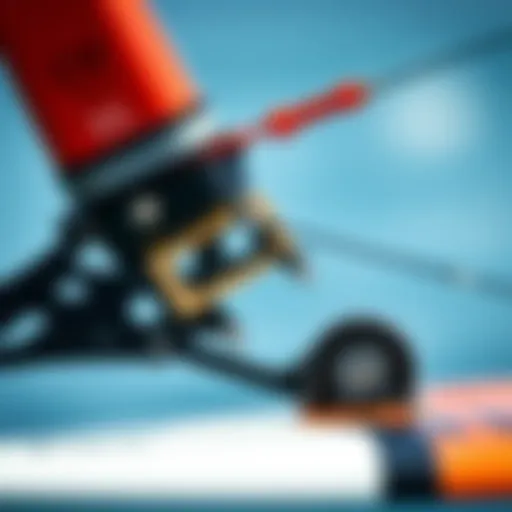Examining Weather Patterns for Kiteboarding in Pasco, WA
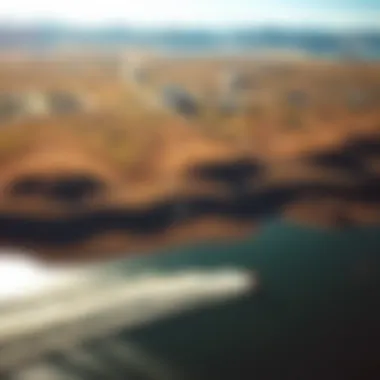

Intro
Pasco, Washington, often overlooked by many kiteboarding enthusiasts, offers a unique blend of wind patterns, climatic conditions, and natural beauty that can significantly enhance the kiteboarding experience. Nestled in the southeastern corner of the state, Pasco experiences weather variations through the seasons that can directly influence how, when, and where kiteboarding adventures take place. Understanding these weather patterns isn't just a nice-to-have; it’s essential for every kiteboarder wanting to make the most out of their rides.
In this analysis, we’ll delve into seasonal weather shifts, evaluate crucial wind conditions, look at rainfall and temperature trends, and how they all sync together to create an ideal kiteboarding environment. Each aspect plays a vital role in both planning your trips and ensuring that gear selection and safety measures are up to par. For beginners and seasoned veterans alike, navigating the kiteboarding landscape in Pasco with this knowledge can make for safer, more enjoyable outings.
Throughout this article, expect to uncover practical insights that reveal the best times of the year for riding. You’ll come away with a comprehensive understanding of how Pasco's unique weather dynamics can be a kiteboarder's ally or adversary, depending on their preparations and knowledge. So, strap in and get ready to chart your course through the winds of Pasco!
Preamble to Pasco's Climate
Understanding Pasco's climate is crucial for kiteboarding enthusiasts, as the interplay of weather patterns directly affects riding conditions. Kiteboarding is not merely a recreational activity; it requires precise timing, knowledge, and an appreciation for the natural elements. Whether a novice taking their first leap into the wind or an experienced rider chasing the perfect gust, knowing the local weather can mean the difference between an exhilarating session and a rather frustrating day on the water.
What sets Pasco apart from other kiteboarding locations? It’s more than just wind and waves. The region boasts unique geographical features that play into its climate dynamics. An appreciation for these details not only enhances the kiteboarding experience but also promotes safety and preparation before hitting the water. With unpredictable weather lurking just around the corner, being informed about the local climate means kiteboarders can adapt their plans accordingly, maximizing fun while minimizing risk.
Geographical Overview
Pasco, located in the Tri-Cities of Washington State, is nestled within the confluence of the Columbia, Snake, and Yakima rivers. This region is characterized by its high desert environment, which significantly influences its weather patterns. The surrounding mountains have a moderating effect on the local climate, creating unique wind patterns that are a kiteboarder's best friend.
The landscape is dotted with rolling hills and flat plains, making it an ideal locale for wind sports. This geographical arrangement is instrumental in the development of consistent wind conditions, especially during the spring and summer months. Moreover, the proximity to large bodies of water such as the Columbia River introduces additional variables, like thermal winds, which can boost wind speeds and ultimately enhance kiteboarding conditions.
Also, Pasco offers relatively mild winters compared to other regions, which allows for kiteboarding even during the colder months, albeit with different gear considerations. The blend of elements – from geography to climate – creates a unique microcosm for both beginners and seasoned kiteboarders looking to test their skills.
Significance of Weather for Kiteboarding
The relationship between weather and kiteboarding cannot be overstated. Kiteboarders rely heavily on stable wind conditions, as inconsistent gusts can lead to unstable riding experiences. Therefore, comprehending seasonal weather changes is paramount for anyone aiming to take to the skies with a kite.
In Pasco, the winds tend to blow consistently from the west during the afternoon, thanks to warm air rising over the land and drawing in cooler air from the water. This phenomenon, known as thermal winds, results in predictable afternoon wind patterns, creating an ideal environment for kiteboarding. It’s critical that kiteboarders capitalize on these windows to ensure they have an enjoyable experience on the water.
Additionally, weather patterns affect temperature and precipitation, which can also impact kiteboarding. Cooler temperatures can necessitate different gear choices, while increased rainfall may lead to less favorable conditions. Therefore, keeping an eye on forecasts and understanding the nuances of local weather changes can greatly enhance the overall kiteboarding experience.
"Knowledge is power, especially when it comes to riding conditions. Understanding the weather can turn a good session into a great one."
As we delve deeper into the seasonal breakdowns and specific factors influencing the kiteboarding scene in Pasco, having a solid grasp of the region's climate will prepare enthusiasts for the thrills that await them in the sky.
Monthly Breakdown of Weather Conditions
Understanding the monthly variations in Pasco's weather is crucial for kiteboarding enthusiasts. Each season presents distinct challenges and opportunities, affecting not just the quality of riding but also safety and gear selection. A kiteboarder well-acquainted with these changes can optimize their time on the water, avoiding unsuitable conditions that could hamper their experience.
Winter Patterns
During winter, particularly from December to February, Pasco experiences cooler temperatures and some precipitation, usually in the form of light rain rather than heavy snowfall. Average highs hover around 40°F to 50°F. Wind conditions are often less predictable, with fewer consistent gusts. For kiteboarders, this means that while the scenery along the Columbia River may be stunning, the riding opportunities can be few and far between. Layered clothing is essential, as temperatures can dip dramatically, especially in the evenings.
Particularly on sunny days, wind can unexpectedly pick up, providing short bursts ideal for enthusiastic riders. A piece of advice: always keep an eye on the water, as winter storms can suddenly change conditions.
Spring Trends
As spring unfolds, between March and May, temperatures start their gradual ascent, reaching an average of 60°F by late May. This period is often marked by increased gusty winds, a boon for kiteboarders eager to hit the waves. The combination of warmth and wind creates perfect kiteboarding conditions.
The early spring months can be a mixed bag, however. Rain is not uncommon, which can make for damp conditions. Kiteboarders should prepare for fluctuating weather. Protective gear is advisable, as quick changes in temperature can catch anyone off guard. In April, expect more stable wind patterns and more enthusiastic kiteboarding sessions as temperatures rise.
Summer Peaks
Summer, stretching from June to August, is undeniably the star of the kiteboarding calendar in Pasco. With average temperatures ranging from 80°F to 95°F, the hot and dry months foster ideal conditions. Consistent winds are more likely, often peaking in the afternoon as the sun heats the earth, creating thermal winds.
- Wind Patterns: Typical summer wind patterns can range between 15 and 25 mph, sometimes even gusting higher.
- Sun Protection: Long hours in the sun necessitate the use of sunscreen and protective clothing to mitigate the risk of sunburn.
Many local kiteboarding competitions take place during these months, showcasing the community spirit and vibrant culture around the sport. Water temperatures are also more inviting, allowing for longer sessions without discomfort.
Autumn Transitional Phase
Autumn brings a transition in weather that can be both delightful and unpredictable. From September to November, temperatures begin to drop back to the 50s and 60s. Winds can be variable, providing less consistency than summer but still often offering some exciting sessions.
This is a great time for those who enjoy kiteboarding in fewer crowds while still relishing decent winds, especially during September, when lingering summer heat casts a warm embrace. The visuals throughout autumn are stunning, with colorful leaves framing the kiteboarding landscape. Nonetheless, as winter edges closer, kiteboarders may find themselves needing to adjust their gear and attire once again. The chilly evenings remind everyone of the impending winter months.
Wind Conditions and Their Influence
Understanding the wind conditions is paramount for kiteboarding enthusiasts in Pasco. Wind is the driving force behind kiteboarding, and its variations can greatly affect the safety and enjoyment of riders on the water. Different wind patterns not only determine the best times for riding but also impact the types of gear that should be used to ensure optimal performance. For kiteboarders, being aware of wind conditions means less guesswork and more time riding.


Prevailing Wind Directions
In Pasco, the predominant wind direction comes from the west and southwest. This is particularly important for kiteboarders because these directions often provide consistent and reliable winds throughout the seasons. Winds blowing from this direction tend to be stronger due to the local topography, especially as they come off the Columbia River. Other directions, such as north or east winds, can be less predictable and might produce turbulent conditions, which can be challenging for both novices and experienced riders.
Kiteboarders should also consider that the time of day can affect wind direction. Typically, the winds in Pasco start to pick up in the afternoon, often reaching their peak by late afternoon or early evening. This pattern offers ideal riding conditions, as the wind gathers strength after the solar heating of the land. Therefore, planning kiteboarding sessions around these peak wind hours can lead to more exhilarating rides.
Wind Speed Variations
Wind speed in Pasco varies significantly throughout the year, reflecting seasonal shifts and local weather patterns. In spring and summer, kiteboarders often enjoy some of the most favorable wind conditions. Average wind speeds can range from 15 to 25 miles per hour, making for thrilling and dynamic sessions on the water. The consistent breeze not only enhances performance but also reduces the likelihood of kite dropout, allowing riders to focus entirely on their skills.
As autumn rolls in, wind speeds can begin to mellow, but there are still plenty of good days for kiteboarding. Winter, on the other hand, can bring a mixed bag of lighter winds interspersed with fierce gusts. This variability means that kiteboarders must stay sharp and adjust their riding techniques depending on the day’s conditions. Familiarity with local wind patterns enables riders to adapt quickly and handle unexpected challenges, ensuring a safer and more enjoyable experience.
Gust Potential Analysis
Gusts are another critical element to consider for kiteboarders, as they can make or break a session. In Pasco, wind gusts tend to occur most frequently during the spring and can sometimes be linked to the local microclimates. A sudden shift in wind speed can catch even seasoned riders off-guard, causing potential control issues.
It is essential to pay attention to the local forecasts and on-the-ground indicators during a session. Observing the water surface can provide hints about gust patterns; ripples or small waves can indicate changes in wind strength. Experienced kiteboarders often say that learning to read these signs is just as important as having the right gear. Understanding gust dynamics allows for better anticipation of changes, helping riders to maintain control and thrive on the water, no matter what Mother Nature throws their way.
"Mastering wind conditions is half the game in kiteboarding. Knowledge is power!"
Kiteboarding in Pasco offers unique opportunities for those who dive into the intricacies of wind dynamics. With the right information, gear, and preparation, riders can look forward to unforgettable experiences on the water.
Temperature Trends Throughout the Year
Understanding the temperature trends in Pasco, Washington, is paramount for kiteboarding enthusiasts. The area's climate directly influences not only the comfort but also the safety and overall experience of a kiteboarder. With varying temperatures throughout the year, enthusiasts must choose the right time for their pastime to ensure optimal conditions.
Average Monthly Temperatures
Pasco experiences a distinct range of temperatures that ebb and flow with the seasons. Here’s a glimpse of the average monthly temperatures:
- January: 34°F - 45°F
- February: 36°F - 49°F
- March: 39°F - 54°F
- April: 42°F - 62°F
- May: 50°F - 70°F
- June: 56°F - 80°F
- July: 62°F - 90°F
- August: 60°F - 89°F
- September: 55°F - 80°F
- October: 43°F - 64°F
- November: 36°F - 52°F
- December: 32°F - 45°F
As we can see, summer months generally peak, making it prime time for kiteboarding. Notably, during July and August, temperatures can soar, creating delightful conditions for enthusiasts eager to ride the winds.
Impact of Temperature on Riding Conditions
Temperature plays a crucial role in kiteboarding. Two primary aspects are worth mentioning:
- Equipment Performance: Kiteboarding gear is designed to perform optimally within certain temperature ranges. Warmer temperatures may require lighter wetsuits or even shorts, while cooler months necessitate thicker suits for warmth. Ensuring gear is suitable for the temperature can prevent discomfort and enhance performance.
- Wind Conditions: Variations in temperature also influence wind dynamics. Colder air is denser than warm air, leading to generally more stable wind conditions in the winter. However, summer heat can create thermal winds, which are exciting for kiteboarding but may be unpredictable.
"A kiteboarder's experience is often determined by the synergy between gear and weather. Knowing the temperature can make or break a ride."
To sum up, keeping an eye on temperature trends allows kiteboarders to not only prepare adequately but also ensure that their riding conditions are safe and enjoyable. Harnessing warm summer breezes or navigating the brisk winter winds can shift the ride from mundane to exhilarating—decision making that is as vital as the sport itself.
Precipitation Patterns in Pasco
Understanding the patterns of precipitation in Pasco is essential for kiteboarding enthusiasts. As any seasoned kiteboarder will tell you, the weather can make or break your experience on the water. Rainfall can influence not only the wind conditions but also the overall riding environment. This section delves into how rainfall varies throughout the year, the implications for kiteboarders, and how to best prepare for wet weather when planning a session.
Monthly Rainfall Averages
Pierce County gets its fair share of rain, yet the distribution can be quite uneven over the year. Here’s a closer look at the average monthly rainfall in Pasco:
- January: 1.5 inches
- February: 1.3 inches
- March: 1.4 inches
- April: 0.9 inches
- May: 0.7 inches
- June: 0.4 inches
- July: 0.2 inches
- August: 0.3 inches
- September: 0.6 inches
- October: 1.1 inches
- November: 1.5 inches
- December: 1.6 inches
It's clear that the summer months are quite dry, making them especially appealing for kiteboarding.
During the peak summer season, rainfall diminishes greatly, providing optimal conditions for outdoor activities. In contrast, late fall and winter bring increased precipitation, which can result in muddy launches and less favorable conditions for kiteboarding. Knowing this seasonal variation can greatly aid kiteboarders in forecasting their best days on the water.
Effects of Rain on Kiteboarding
Rain can be a double-edged sword for kiteboarders. On one hand, it might create a refreshing atmosphere during a hot summer day; on the other hand, too much moisture can lead to challenges. Here’s what to keep in mind regarding how rainfall impacts your kiteboarding adventures:
- Wind Alterations
- Water Conditions
- Launch Sites
- Adverse Weather Signs
- Gear Considerations
- Rain can shift wind patterns and speed. During a steadier rain, you may find wind conditions dipping, which may not be ideal for riding. Monitoring forecasts closely is vital.
- Rain often leads to fresher water conditions, especially after a dry spell. This can reduce algae blooms and improve clarity, offering a better experience. However, a heavy downpour may also wash debris into the water, increasing hazards.
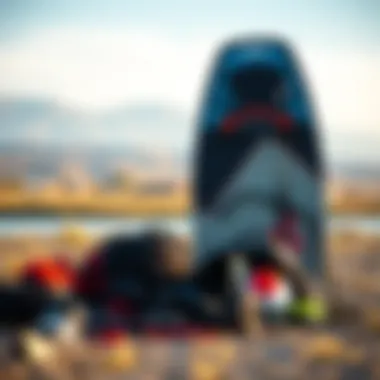

- Wet grounds can make some locations challenging to navigate. Launching from muddy or saturated areas can lead to equipment damage or safety risks. Choosing your launching point wisely becomes crucial.
- Increased cloud cover often accompanies rain, which might drop visibility. A sudden storm might prompt wind shifts that can catch even the most prepared riders off guard. Always check the forecast before heading out.
- Different types of kites handle conditions best in varying situations. It’s beneficial to select gear designed to repel water or that has higher durability in wet conditions.
Rainfall opens the door to not only new challenges but also opportunities for more vibrant and varied kiteboarding experiences. As a kiteboarding enthusiast, understanding the intricacies of Pasco's precipitation patterns can elevate your time on the water.
Unique Climate Features of Pasco
Pasco's climate presents some distinctive features that can profoundly influence kiteboarding conditions. Understanding these unique elements is crucial for kiteboarders who intend to make the most of their time on the water, allowing them to anticipate and adapt to various weather conditions.
Rain Shadow Effect
One of Pasco's most significant weather characteristics is the rain shadow effect, resulting primarily from the nearby Cascade Mountains. This phenomenon occurs when moist air masses migrate from the ocean and rise over the mountain ranges. As the air ascends, it cools, leading to condensation and precipitation on the windward side of the mountains. By the time the air descends into Pasco, it loses much of its moisture, creating a dry and arid environment.
This dry spell can be a double-edged sword for kiteboarders. On one hand, fewer rainy days can mean more days with suitable wind conditions, allowing for extended riding periods. On the other hand, it’s vital for kiteboarders to remain aware of how this aridity impacts water levels in local lakes and rivers. Lower-than-normal water levels might create hazards or shift riding areas, so staying informed about local conditions is key.
"The rain shadow effect makes kiteboarding in Pasco distinctly favorable; however, it’s important to keep tabs on water conditions as they can fluctuate quietly."
High Desert Influence
Pasco is part of the larger High Desert region, characterized by its elevation, dry air, and distinct seasonal temperature fluctuations. This high desert influence plays a significant role in both the climate and kiteboarding conditions in Pasco. The terrain features, with vast stretches of open land and minimal obstructions, contribute to consistent wind patterns that kiteboarders often look for.
In summer, the high desert can experience soaring temperatures, with highs pushing well over the 90-degree mark. However, the evenings often bring a welcome drop in temperature, allowing for comfortable riding conditions. During this time, kiteboarders might find the higher elevations advantageous as winds often peak in the late afternoon when temperatures start retreating.
The high desert's effects also extend to the unpredictability of weather. Sudden gusts can spring up due to thermal differences throughout the day, so knowing how to read the winds becomes instrumental. Kiteboarders must remain alert and adaptable, ready to adjust gear and technique based on these swift shifts in environment.
Overall, grasping the unique climate features of Pasco enhances a kiteboarder's ability to prepare and react, ultimately enriching the kiteboarding experience.
Preparing for Kiteboarding in Pasco
Kiteboarding in Pasco, Washington, offers not just thrilling experiences but also requires a keen understanding of weather conditions. When you’re planning a kiteboarding session, knowing how to prepare is key to staying safe and enjoying the ride. This article section aims to outline not just the elements to consider but also the tangible benefits of being prepared. When you take proactive measures, it can make all the difference between a successful day on the water and a struggle against the elements.
Selecting the Right Gear Based on Conditions
Adapting to the local weather means having the right gear in your kit. Kiteboarders in Pasco face a variety of situations depending on the season, wind patterns, and temperature variations. Here are some core considerations when selecting gear:
- Kite Size: Depending on the wind speed, adjusting your kite size is crucial. Lighter winds may need a larger kite for proper lift, while stronger winds call for smaller kites for control. Kiteboarders often talk about the importance of having multiple sizes in their arsenal.
- Wetsuits: The water temperature can change drastically throughout the year. In winter, a thicker wetsuit is necessary, often around 5mm, while summer may allow for a 2mm or even a shorty. Layering can be your best friend during transitional seasons for flexibility.
- Footwear: Depending on the conditions and whether you’re on a surfboard or a twin-tip, booties can provide the grip and warmth you need. Furthermore, some riders prefer straps versus bindings based on the water conditions.
- Safety Gear: Proper safety equipment, such as impact vests and helmets, can be lifesavers. The waters of the Columbia River can have unexpected currents, so keeping safety at the forefront is essential.
When kiteboarders are well-equipped, they make the most of every breezy opportunity.
Techniques to Adapt to Weather Changes
Weather can be unpredictable. Based on local anecdotes from experienced kiteboarders, many agree that learning to adapt on the fly is part of the adventure. Here are some techniques to help you stay ahead of any weather surprises during your kiteboarding sessions:
- Monitor Forecasts: Regularly check weather forecasts and updates through reliable sources such as NOAA and local weather apps. Having several tools at your disposal can help you anticipate changes better.
- On-the-Fly Adjustments: Develop the skill to read the wind patterns in real-time. This not only helps in recognizing when to launch your kite but also when it’s best to pack it up and head home. Experienced locals often know how to adjust their riding style according to gust patterns, which is a valuable skill.
- Plan for Variety: Have a flexible plan once you’re on the water. If winds shift dramatically, being ready to switch from freestyle to wave riding can enhance your overall experience. Many kiteboarders share tips about how a quick mindset shift can lead from struggling to thriving.
- Stay Informed by the Community: Engaging with local kiteboarding communities can provide insights into current conditions, safety tips, and weather trends that are not always found in official forecasts. Platforms like Reddit can have threads packed with local knowledge that might not be on any weather map.
"The sea is unpredictable, just like the wind. Adaptation is not just a skill, it's a necessity for every kiteboarder."
By honing your skills in gear selection and adaptation techniques, kiteboarding can become not simply a sport but a deeply enriching experience in Pasco's dynamic environment.
Safety Considerations Related to Weather
Kiteboarding, while exhilarating, can quickly turn daunting under unfavorable weather conditions. Understanding how weather plays a role in safety is not just smart; it’s essential. When you’re zipping across the water, the last thing you want is a sudden gust or an unexpected storm ruining your day.
Identifying Hazardous Conditions
To promote safe kiteboarding experiences, it’s crucial to recognize potentially dangerous weather patterns. Kiteboarders should be aware of specific elements that can indicate hazardous conditions:
- High Wind Speeds: Winds above 25 knots can challenge even the most experienced riders. It’s like taking a roller coaster with no safety harness!
- Storms and Inclement Weather: Rapid changes in weather, particularly the approach of storms, can create perilous surf conditions. Be mindful of dark clouds rolling in; they often bring high winds and rain.
- Restricted Visibility: Fog or heavy precipitation can drop visibility considerably. If you can’t see where you are going, it’s time to reassess your plans.
By keeping a close watch on weather forecasts and real-time updates, kiteboarders can learn how to navigate these challenges effectively. As the saying goes, "Better safe than sorry!"
Emergency Preparedness
Preparation is half the battle when faced with unpredictable weather while kiteboarding. Taking the time to prepare can make a significant difference in ensuring safety during your time on the water. Here are tips on developing an effective emergency plan:
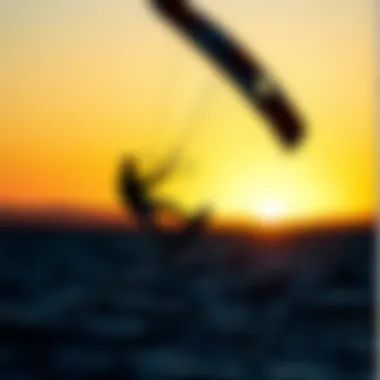
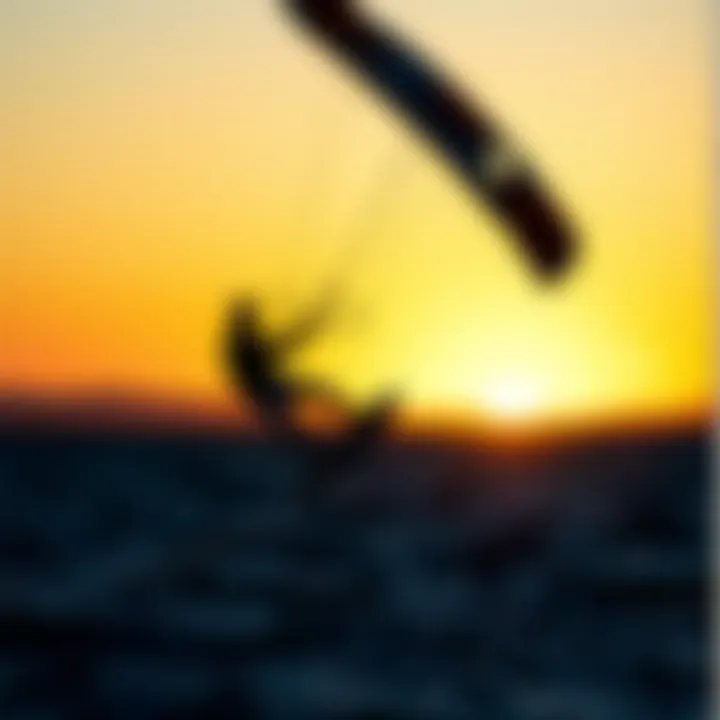
- Know Your Location: Familiarize yourself with safe landing zones and nearby emergency services. Knowing where to go in a crunch can save precious minutes.
- Communication: Have a buddy system in place. Make sure someone is aware of your whereabouts and intended return time. Using a waterproof phone cover can help keep communication lines open.
- Gear Check: Regular inspections of equipment are vital. Make sure your kite and lines are free from damage, as a failing kite can create serious safety risks.
- First Aid Kit: Carry a compact first aid kit in your gear bag. You never know when you might need it, whether it's for scrapes or more serious injuries.
- Weather Monitoring Tools: Utilize apps like Windy or the NOAA Weather Radar to stay updated on changing conditions during your sessions. Making use of local sites such as Weather.com and NOAA can help in achieving a safer outing.
Adopting these strategies fosters a culture of safety among kiteboarders, emphasizing that while thrill is part of the sport, survival can’t be ignored. In the end, kiteboarding should be full of memorable experiences, not harrowing tales!
Kiteboarding Community Insights
Understanding the local kiteboarding scene in Pasco, Washington, goes hand in hand with grasping the nuances of its weather patterns. This section aims to shed light on how the kiteboarding community thrives on shared experiences and collective wisdom drawn from navigating Pasco's unique climate. Enthusiasts, both seasoned and novice, benefit considerably from tapping into this reservoir of local knowledge.
Local Experiences with Weather Variations
Pasco's weather isn't just about numbers on a forecast; it's an ever-evolving tapestry of conditions that shape every kiteboarding session. The local community frequently discusses their firsthand encounters with fluctuating winds and changing temperatures, offering invaluable insights for others looking to ride the air. For instance, many kiteboarders highlight the importance of adjusting their strategies based on the time of year. A common theme arises during the summer months when temperatures soar, leading to thermal winds that kick up in the early afternoon.
- Some kiteboarders have noted that early morning sessions can be pleasant, thanks to cooler temperatures, but as the day progresses, they must adapt to stronger winds. This knowledge comes from repeated experiences in the field, painting a vivid picture of what conditions to expect.
Moreover, the community heartily shares tales of unexpected gusts that may catch newcomers off guard, effectively underlining the importance of local wisdom in understanding the shifts in weather. These shared experiences aren't only educational; they foster a sense of camaraderie among kiteboarders who can relate to the challenges and joys of their sport, creating a supportive environment where everyone has something to learn.
Sharing Knowledge Among Enthusiasts
The exchange of information within the kiteboarding community in Pasco is pivotal. Local riders often engage in sharing knowledge through forums, social media groups, and informal meetups. Whether discussing optimal equipment for various wind conditions or alerting fellow enthusiasts about a sudden weather change, the act of sharing transforms individual experiences into a collective playbook for success.
Key Areas of Knowledge Sharing:
- Weather Forecasting: Many enthusiasts recommend specific reliable weather apps that cater to kiteboarders, encouraging consistent check-ins for real-time updates on gust patterns and temperature fluctuations.
- Safety Tips: Sharing firsthand experiences regarding safety protocols contributes significantly to enhancing fellow kiteboarders' preparedness for unpredictable weather.
- Technique Adjustments: Seasoned kiteboarders often provide tips on how to adjust riding techniques based on current conditions—advising on everything from choosing the right kite size to airflow best practices.
"The beauty of our community lies in its openness to share. Someone’s loss can be another’s gain—be it knowledge about wind patterns or advice on handling a tricky ride."
Just as the winds can change without notice, so too can the knowledge gleaned from those who’ve faced similar challenges. Every kiteboarder can benefit from the seasoned voices of their peers, not just to enhance their riding but also to build connections that deepen their passion for the sport.
Forecasting Tools and Resources
Understanding weather is like trying to predict the lottery. Sometimes, the forecast hits the nail on the head, and other times, it's just a fluke. For kiteboard enthusiasts in Pasco, having the right tools and resources to forecast conditions can make the difference between a stellar day on the water and a frustrating fiasco. Accurate forecasts help kiteboarders know when to pack their gear and head to the river or when to stay at home, relaxing with a good book.
Recommended Weather Apps
In today’s digital age, having the right weather app is akin to having a trusty map in the great outdoors. Here are a few noteworthy apps that are particularly savvy when it comes to kiteboarding conditions:
- Windy: This app provides incredibly detailed wind forecasts. You can view wind streams in real-time and can even look into different altitudes. The interface is user-friendly, making it simple to see what’s happening at a glance.
- Weather Underground: Offers hyper-local forecasts, which is ideal for kiteboarders wanting specifics. Users can even contribute local weather reports, enhancing the data's reliability.
- KiteScene: Tailored specifically for kiteboarders and other water sports enthusiasts. It combines wind and weather data in a straightforward way, helping kiteboarders make quick decisions.
These applications host a treasure trove of features, including interactive maps, wind profiles, and notifications based on specific location settings. This specificity can ensure kiteboarders make informed choices about when to hit the waves.
Utilizing Local Meteorological Services
While apps are nifty little gadgets, local meteorological services often provide in-depth knowledge that a general app may overlook. These services include:
- National Weather Service (NWS): The NWS offers detailed forecasts and warnings. By checking your local NWS station, kiteboarders can access specific alerts and updates applicable to Pasco, enhancing safety measures.
- Local Universities: Several universities often conduct research on the local climate patterns and share insights freely. Tapping into this can offer kiteboarders unique perspectives on historical weather data.
Engaging with local meteorological resources can foster a deeper understanding of the region's climate. For example, contacting a local university department might uncover patterns unique to certain times of the year, which isn’t always apparent in standard weather reports.
Knowledge in weather forecasting isn’t just a nice-to-have; it’s a necessity for kiteboarders wanting to maximize their experience.
In sum, while smartphone technology offers convenience, combining it with insights from local meteorological services cultivates an exceptional toolkit for navigating the winds of Pasco. By keeping an eye on both, kiteboarders can thrive amid the unpredictable elements.
End and Future Weather Trends
In the grand scheme of kiteboarding, understanding the weather patterns of Pasco, Washington, is not just a feather in the cap; it's central to ensuring a safe and enjoyable riding experience. As highlighted throughout this article, the predictable shifts in weather — from wind patterns to precipitation levels — significantly influence every aspect of the sport. Kiteboarders need to grasp these elements to enhance their performance and make informed decisions. This section delves into the final thoughts on why such understanding is pivotal and what the future may hold regarding climate changes that could impact kiteboarding in Pasco.
Final Thoughts on Pasco's Weather for Kiteboarding
As we close this discussion, it’s worth emphasizing several key insights regarding Pasco's unique climate. For kiteboarding enthusiasts, seasons aren’t just part of the calendar; they dictate when, where, and how one rides. With Pasco's hot summers that often bring strong winds, it’s clear why many kiteboarders flock to the region during these months. However, spring and autumn, with their shifting weather patterns, don’t deserve to be sidelined. The transitional seasons can offer some phenomenal riding opportunities, too, though they require a more tailored approach to gear and technique.
In addition to seasonal variations, the local geography, including the impact of the Columbia River and surrounding landscapes, plays a fundamental role in determining the wind and weather conditions. Riding here isn’t merely about following a general forecast; it’s about becoming intimately acquainted with your local environment. This knowledge can lead to safer and more satisfying kiteboarding experiences.
Anticipated Climate Changes and Implications
As we look ahead, it’s prudent to consider the broader picture. Climate change is not just a buzzword; it affects weather patterns globally. For Pasco, this could mean altered precipitation levels, shifting temperatures, and even unexpected wind patterns. While the current forecasts may seem predictable, the reality is that both local and global elements can and do affect these patterns.
For kiteboarders, the implications of these shifts could be significant. If wind conditions become more erratic, for instance, kiteboarders may need to adapt their techniques or gear more frequently. Sustainability becomes a central concern as well; preserving the waterways and landscapes that make Pasco a kiteboarding hub is essential not just for immediate enjoyment but for future generations.
The combination of environmental awareness and adaptation strategies will be vital in navigating these anticipated changes. Staying engaged with the local kiteboarding community will be crucial for sharing insights and experiences, as they will help in adjusting to the evolving conditions. Local clubs and social media platforms might prove valuable resources for real-time updates and camaraderie in facing these challenges together.
"The ability to adapt is more important than the ability to predict." This quote emphasizes the necessity for kiteboarders to embrace change, understanding that flexibility will define future success on the water.
In summary, kiteboarding in Pasco offers a dynamic adventure, shaped heavily by the area’s temperamental weather. As the climate continues to change, remaining informed and prepared will allow kiteboarders not just to ride the waves but to thrive in a shifting environment. The future of kiteboarding in Pasco can be bright, as long as riders stay informed and adapt to the weather's whims.











